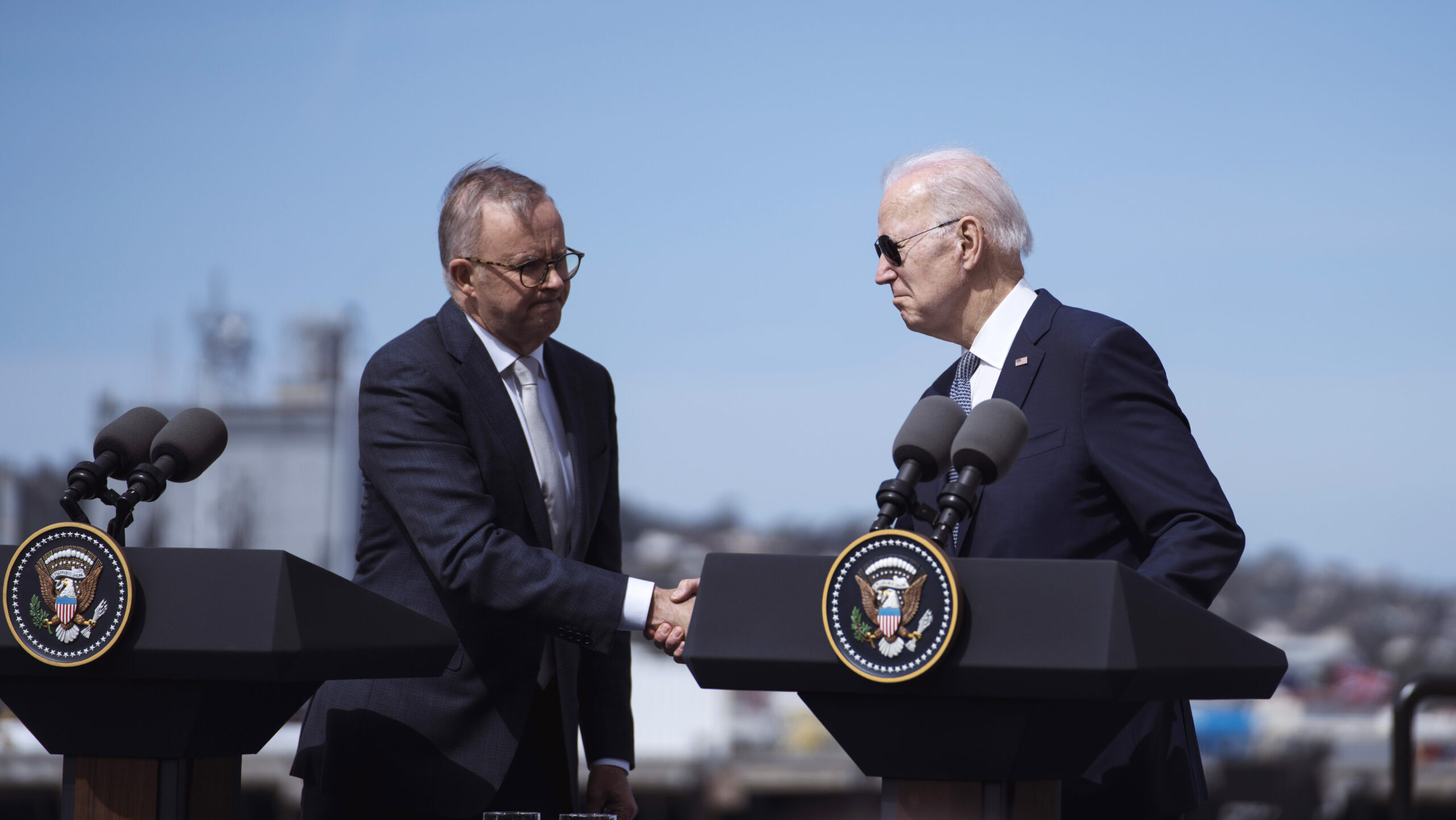
Anthony Albanese, Australia’s prime minister, left, and US President Joe Biden shake hands at Naval Base Point Loma in San Diego, California, US, on Monday, March 13, 2023. (Eric Thayer/Bloomberg via Getty Images)
WASHINGTON — There is an expectation that this week’s first official state visit by Australian Prime Minister Anthony Albanese will be accompanied by formalizing an agreement that will allow US commercial space companies to use launch from Down Under, Breaking Defense has learned.
Generally speaking, official state visits are often accompanied by a package of announcements between the US and its guest. Finalization of a technical safeguards agreement (TSA) between the two close partners would be an easy win, and one that several sources suggested to Breaking Defense is on the table.
“I suspect this will link to the finalization or implementation of the technical safeguards agreement which will allow US commercial launch companies to operate from Australian launch sites. I don’t have any info specifically but am hearing its likely to related to the TSA,” Bec Shrimpton, national security director at the Australian Strategic Policy Institute, told Breaking Defense.
Negotiations on the TSA began in October 2021, and Albanese and Biden reached an “agreement in principle” in May on the sidelines of the G7 meeting in Japan. However, final details had yet to be worked out.
“Space collaboration is a rich opportunity to build high-skilled, well-paying jobs and increase investment between our countries. Australia and the United States have reached agreement in principle, subject to final domestic authorisations, on the Technology Safeguards Agreement, to allow for the controlled transfer of sensitive US launch technology and data while protecting US technology consistent with US non‑proliferation policy, the Missile Technology Control Regime and US export controls,” the two governments said in a May 20 statement.
Biden also promised during the meeting “to ask the United States Congress to add Australia as a ‘domestic source’ within the meaning of Title III of the Defense Production Act,” according to the statement. “Doing so would streamline technological and industrial base collaboration, accelerate and strengthen AUKUS implementation, and build new opportunities for United States investment in the production and purchase of Australian critical minerals, critical technologies, and other strategic sectors.”
AUKUS is the trilateral security pact between the US, United Kingdom and Australia signed in September 2021, under which the first major initiative has been support for Australia’s plan to acquire conventionally-armed, nuclear-powered submarines. In fact, Washington and London signed a TSA on space launch in June 2020.
The US Space Force is keenly interested in the capability to launch military payloads from Australia and the wider Southern Hemisphere.
Most spacecraft are launched eastward to take advantage of the speed boost provided by the Earth’s rotation, and the closer to the equator — where the Earth’s surface spins the fastest due to the laws of physics — the launch takes place, the bigger that boost. Australia is not only fairly close to the equator, but also launching eastward from the continent allows easier orbital insertion over China.
The US has had a TSA with New Zealand dating back to 2016, and the National Reconnaissance Office has launched several spy satellites, including two co-developed with the Australian Ministry of Defence, from the Mahia Peninsula using Rocket Lab’s Electron booster.
“We need launch capabilities in the Southern Hemisphere. We need launch capabilities outside the United States. We need to enable our allies and partners to be able to launch,” Deanna Ryals, director of international affairs at the Space Force’s Space Systems Command, said Oct. 19. “We’ve got to get through the hurdles that we have, the regulatory problems, to enable our closest and best friends and partners —who are very capable with very awesome geography — to be able to do this, and then we spread that out.
“We spread out the ability to leverage from Australia with Australian launch, Australia payloads to recapitalize. So, if Australia is launching, Japan’s launching, and the US is launching and we’re launching in Europe, there’s nothing that can stop us when we get to that point. But we’ve got to get out of our own way. We’ve got to change regulations,” she told the MilSat Symposium in Mountain View, Calif.
However, the key hurdle for the US-Australian TSA right now is that because it would be a legally binding treaty, the accord must be ratified by both US Senate and the Australian Parliament. And neither Biden or Albanese have much control over the timing of that process, which means it is unclear just how much further they can push toward TSA implementation.
Charles Edel, the Australia Chair at the Center for Strategic and International Studies here, said in an Oct. 16 press briefing that while Biden and Albanese are likely to stress “the expansion of alliance activities over the past several years in the Pacific, on climate, on critical-mineral cooperation, on rising ambitions in clean energy, on defense collaboration and in space,” no major initiatives are likely.
“I wouldn’t necessarily expect big announcements here, but solid, steady progress in all these important areas,” he said.
Colin Clark in Sydney contributed to this report.








